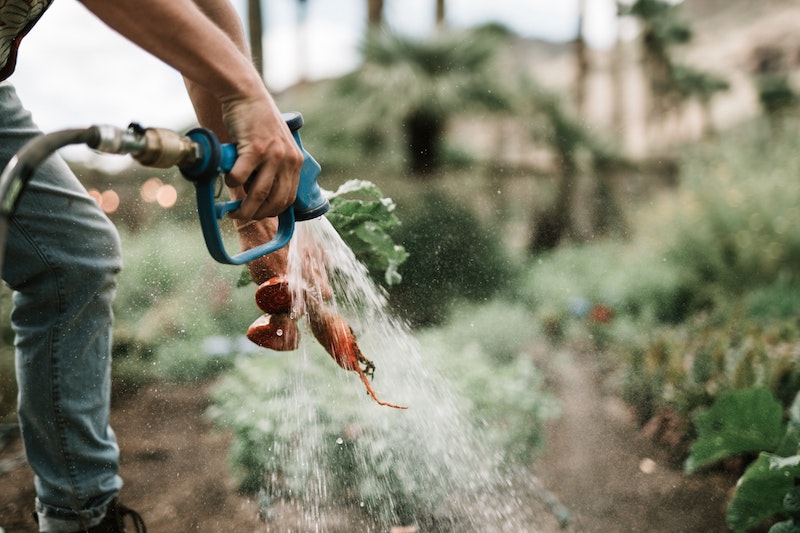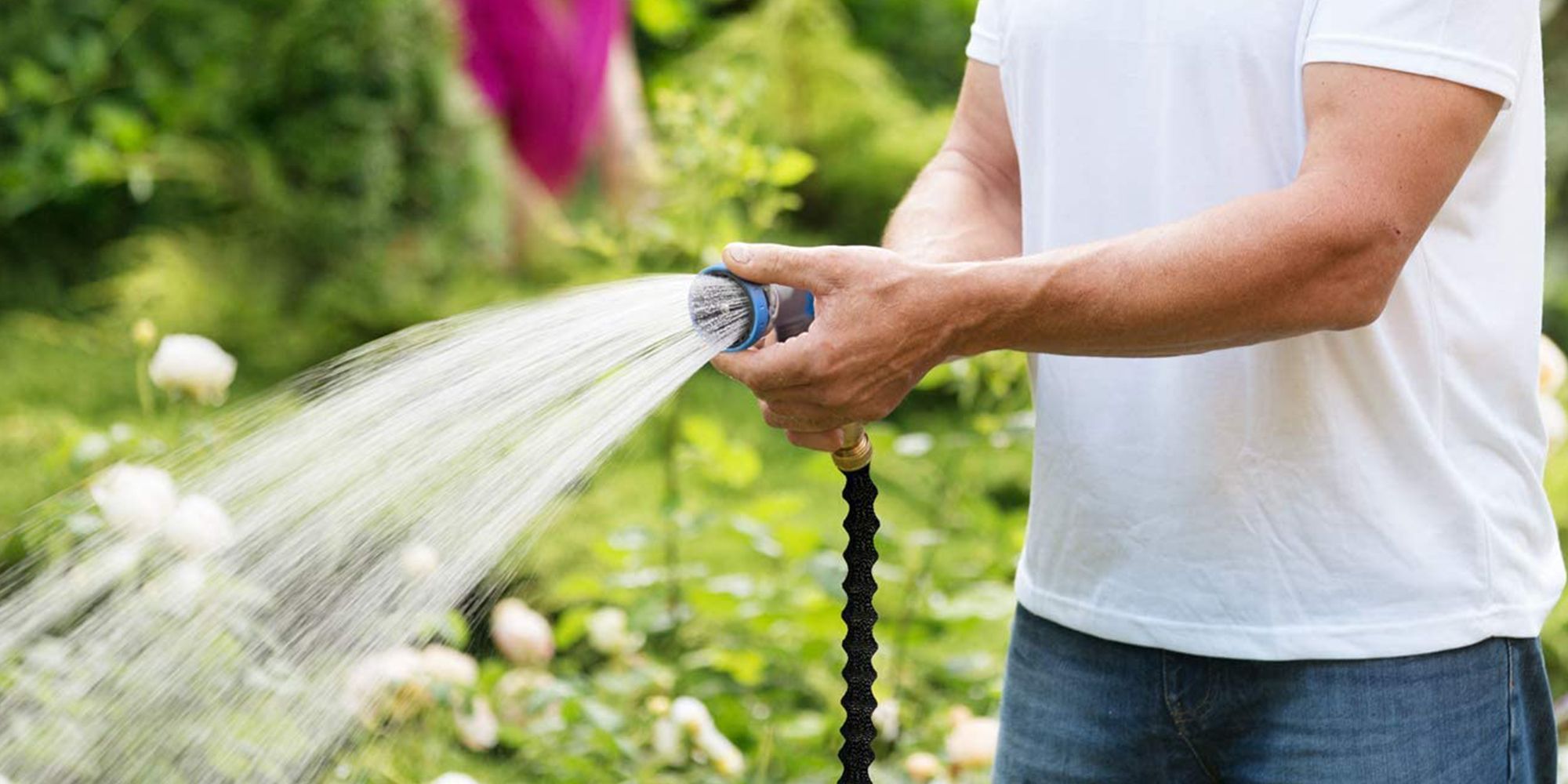Are you looking for information about the best garden hose nozzles and sprayers? Then you have come to the right place. There are so many options out there that even the most seasoned of gardeners have a hard time making the right choice.
In this guide, you’ll find a comprehensive overview of these sprayers and nozzles, as well as information to help you make the right decision for your garden. The guide will also improve your understanding of how to use your nozzle and sprayer. Read on to learn more:

Hose Nozzle Styles
Before you get started on the best garden hose nozzles and sprayers, it is imperative that you learn about the major types of nozzles used for gardening tools. The seven styles you’ll currently find on the market include:
- Pistol Grip
As the name suggests, this sprayer has the same shape as a pistol. Its key features include, but are not limited to:
- – It has a grip that you hold in your hand much in the same way you’d carry a pistol
- – It comes with a trigger/level that you can use to turn the water on/off as well as control the rate of flow
- – It has a nozzle (adjustable or fixed) jutting out from the front
To use the pistol grip nozzle with the best garden hose, all you have to do is point it where you would like to spray and pull the trigger. Releasing the trigger will stop the water flow. Similarly, the flow rate will depend on how much you have depressed the trigger.
Most pistol grip nozzles come with plastic or aluminum construction. Due to the many moving parts, they tend to wear out and break apart easily. Therefore, you need to invest in a high -quality pistol grip nozzle if you wish to use it over the long haul.
- Dial/Turret Nozzles
Dial nozzles also referred to as turret nozzles, come in a wide variety of shapes and styles. The most common are the watering wand and the pistol grip kinds. However, the key feature of this type of nozzle is that you’ll be able to turn a dial if you wish to adjust the pattern of the spray.
The nozzles range from 2 to 8 (or more) spray patterns — including flood, soak, center spray, mist, shower, cone, flat, fan, or jet.
Dial garden hose nozzles are best suited for people who need to do tons of close watering. They also work well when you need to change the water spray pattern. Since they have a mist setting, you can easily use them on delicate seedlings and plants without running the risk of killing your plants. The soak pattern, on the other hand, will prove useful when you need to water your large containers.
The nozzles are typically made of plastic — even though some are aluminum or a combination of the two materials. If yours is plastic, ensure you keep it indoors if it isn’t in use.
- Watering Wand
Watering wands are specialized garden hose nozzles that will extend the reach of your watering. As such, they work well if you wish to water deep garden beds and hanging baskets.
Some are also designed to telescope or extend for added versatility and length. Others are like the dial nozzle in the sense that they are adjustable. The best, however, come with cut-off triggers/valves that you can use to start/stop the water without having to rush to the faucet. For added comfort, you can also buy a watering wand with rubber or foam insulated grip to ensure your hand is always warm.
- Fan Nozzles
These rank among the best garden hose nozzles in the sense that they will emit water in a fan –shaped pattern, making them ideal for watering outdoor plants and smaller gardens. While some come with a shut-off valve, most of them have no water control. However, if you are looking for something to help you complete your watering task easily and quickly, then the fan nozzle will work out well.
In general, they are designed to dispense copious amounts of water but in a gentle way. This feature makes them ideal for everyday use even on the most delicate of plants and flowers.
- Fireman Nozzles
The fireman nozzle is typically sold in the car care section of hardware stores because it dispenses a lot of water at high speed. Extremely versatile, these sprayers are perfect for emitting everything — from a strong jet to a light mist — just by adjusting the nozzle.
Most of them are metallic, while some have a rubber coating to provide protection and insulation.

- Traditional Nozzles
Otherwise referred to as the straight or cylindrical nozzle, the traditional has a straight but twistable barrel for controlling the water flow. You can change the spray pattern by twisting the end of your tubular nozzle.
Whereas you will get a fine mist or a solid stream from turning the nozzle in one direction, going the other way will completely cut out the flow of water. This design feature makes traditional nozzles best suited for forceful sprays and specific directions.
- Bubbler/Soaker Nozzles
Bubbler or soaker nozzles are not typical. Unlike other garden hose nozzles, they won’t spread water. Rather, the water will slowly bubble or drip out of the device you’ve placed at the end of your hose.
As such, these nozzles are great for watering the most delicate of plants, minimizing water runoff, and soaking newly planted trees.
Understanding Spray Patterns
Most of the best garden hose nozzles and sprayers will allow you to pick the spray pattern. The common patterns include:
- – Slow soaking
- – Focused jets or cones
- – Steady showers
- – Fine mists
To this end, as you go shopping, look for a nozzle setting that will help you achieve the spray pattern you are going to use the most.
Concluding Thoughts
Since there are so many different types of sprayers and nozzles for garden hoses, it is not surprising that some people have a problem picking the right one. If you have some money to spare, consider getting a couple of nozzle styles because you never know when you are going to need what.
Over and above everything else, choosing the best garden hose nozzle will depend on your particular preferences, what you intend to do with your sprayer, and the volume of water you need to dispense, among other factors.
